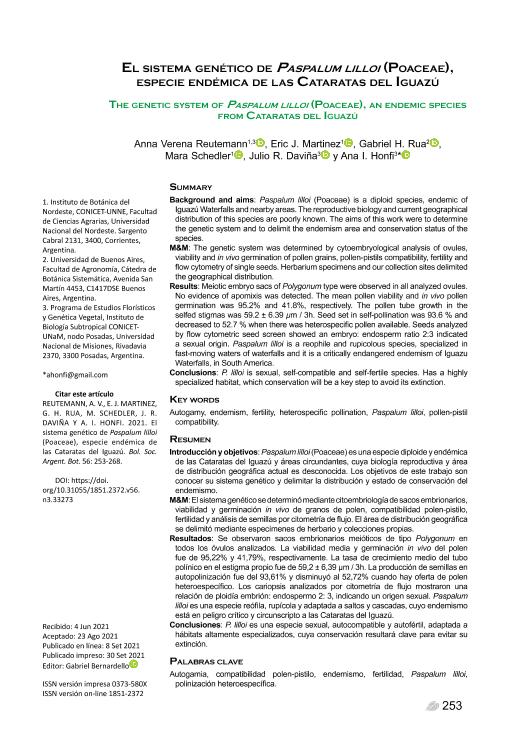Artículo
Introducción y objetivos: Paspalum lilloi (Poaceae)es una especie diploide y endémica de las Cataratas del Iguazú y áreas circundantes, cuya biología reproductiva y área de distribución geográfica actual es desconocida. Los objetivos de este trabajo son conocer su sistema genético y delimitar la distribución y estado de conservación del endemismo. M&M: El sistema genético se determinó mediante citoembriología de sacos embrionarios, viabilidad y germinación in vivo de granos de polen, compatibilidad polen-pistilo, fertilidad y análisis de semillas por citometría de flujo. El área de distribución geográfica se delimitó mediante especímenes de herbario y colecciones propias.Resultados: Se observaron sacos embrionarios meióticos de tipo Polygonum en todos los óvulos analizados. La viabilidad media y germinación in vivo del polen fue de 95,22% y 41,79%, respectivamente. La tasa de crecimiento medio del tubo polínico en el estigma propio fue de 59,2 ± 6,39μm / 3h. La producción de semillas en autopolinización fue del 93,61% y disminuyó al 52,72% cuando hay oferta de polen heteroespecífico. Los cariopsis analizados por citometría de flujo mostraron una relación de ploidía embrión: endospermo 2: 3, indicando un origen sexual. Paspalum lilloi es una especie reófila, rupícola y adaptada a saltos y cascadas, cuyo endemismo está en peligro crítico y circunscripto a las Cataratas del Iguazú.Conclusiones: P. lilloi es una especie sexual, autocompatible y autofértil, adaptada a hábitats altamente especializados, cuya conservación resultará clave para evitar su extinción. Background and aims: Paspalum lilloi (Poaceae) is a diploid species, endemic of Iguazú Waterfalls and nearby areas. The reproductive biology and current geographical distribution of this species are poorly known. The aims of this work were to determine the genetic system and to delimit the endemism area and conservation status of the species. M&M: The genetic system was determined by cytoembryological analysis of ovules, viability and in vivo germination of pollen grains, pollen-pistils compatibility, fertility and flow cytometry of single seeds. Herbarium specimens and our collection sites delimited the geographical distribution. Results: Meiotic embryo sacs of Polygonum type were observed in all analyzed ovules. No evidence of apomixis was detected. The mean pollen viability and in vivo pollen germination was 95.2% and 41.8%, respectively. The pollen tube growth in the selfed stigmas was 59.2 ± 6.39 µm / 3h. Seed set in self-pollination was 93.6 % and decreased to 52.7 % when there was heterospecific pollen available. Seeds analyzed by flow cytometric seed screen showed an embryo: endosperm ratio 2:3 indicated a sexual origin. Paspalum lilloi is a reophile and rupicolous species, specialized in fast-moving waters of waterfalls and it is a critically endangered endemism of Iguazu Waterfalls, in South America. Conclusions: P. lilloi is sexual, self-compatible and self-fertile species. Has a highly specialized habitat, which conservation will be a key step to avoid its extinction.
El sistema genético de Paspalum lilloi (Poaceae), especie endémica de las Cataratas del Iguazú
Título:
The genetic system of Paspalum lilloi (Poaceae), an endemic species from Cataratas del Iguazú
Reutemann, Anna Verena ; Martínez, Eric Javier
; Martínez, Eric Javier ; Rua, Gabriel Hugo
; Rua, Gabriel Hugo ; Schedler, Mara
; Schedler, Mara ; Daviña, Julio Rubén; Honfi, Ana Isabel
; Daviña, Julio Rubén; Honfi, Ana Isabel
 ; Martínez, Eric Javier
; Martínez, Eric Javier ; Rua, Gabriel Hugo
; Rua, Gabriel Hugo ; Schedler, Mara
; Schedler, Mara ; Daviña, Julio Rubén; Honfi, Ana Isabel
; Daviña, Julio Rubén; Honfi, Ana Isabel
Fecha de publicación:
09/2021
Editorial:
Sociedad Argentina de Botánica
Revista:
Boletín de la Sociedad Argentina de Botánica
ISSN:
1851-2372
e-ISSN:
1851-2372
Idioma:
Español
Tipo de recurso:
Artículo publicado
Clasificación temática:
Resumen
Archivos asociados
Licencia
Identificadores
Colecciones
Articulos(IBONE)
Articulos de INST.DE BOTANICA DEL NORDESTE (I)
Articulos de INST.DE BOTANICA DEL NORDESTE (I)
Articulos(IBS)
Articulos de INSTITUTO DE BIOLOGIA SUBTROPICAL
Articulos de INSTITUTO DE BIOLOGIA SUBTROPICAL
Articulos(OCA PQUE. CENTENARIO)
Articulos de OFICINA DE COORDINACION ADMINISTRATIVA PQUE. CENTENARIO
Articulos de OFICINA DE COORDINACION ADMINISTRATIVA PQUE. CENTENARIO
Citación
Reutemann, Anna Verena; Martínez, Eric Javier; Rua, Gabriel Hugo; Schedler, Mara; Daviña, Julio Rubén; et al.; El sistema genético de Paspalum lilloi (Poaceae), especie endémica de las Cataratas del Iguazú; Sociedad Argentina de Botánica; Boletín de la Sociedad Argentina de Botánica; 56; 3; 9-2021; 1-16
Compartir
Altmétricas



